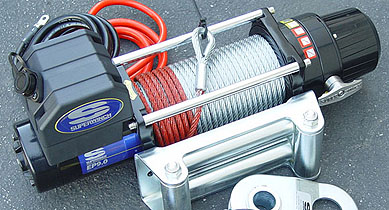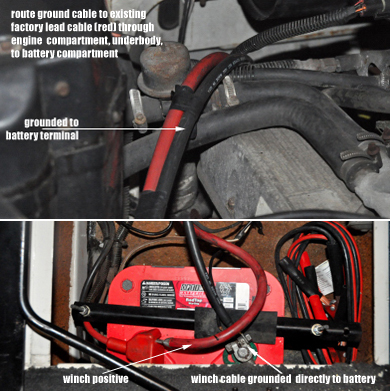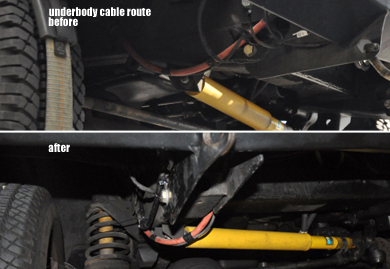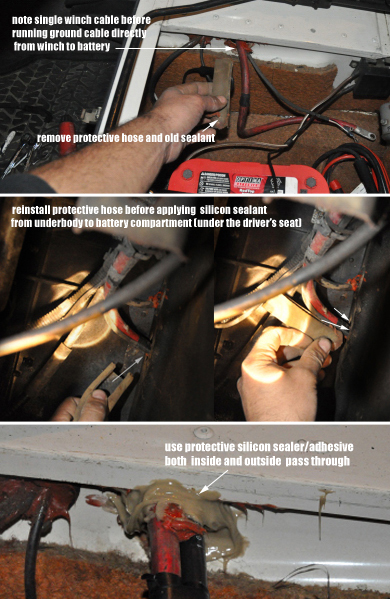 Defender 110 Winch and Bumper |
|
An ideal winch will have 1.5 times the pulling capacity of the weight of the vehicle in pounds. So a winch with pulling capacity of 8000 lbs. and up will do the job for the NAS Defender 110 weighing 5000 lbs. The larger the capacity, the larger the winch motor and solenoid, for the most part. The correct winch for your Defender 110 is a winch that meets the pulling capacity requirement and fits into your bumper. Shown below we will go over the steps needed to connect an aftermarket 9000 lbs. winch on an ARB heavy duty front bumper. It helps to know that most manufacturers make winches with standard fittings. The mounting holes for your front bumper should come ready supporting any standardized winch out there, such as Warn or Superwinch.
A simple 40amp 12 volt, 8000 lbs. winch can demand up to 480watts of peak power under load. Using anything less than a 1 gauge wire/cable may result in burning or igniting your winch cable during peak. For most occasional winch users, a 1 gauge cable matches stock gauge and allows adequate flexibility to be routed from battery to winch. Shown above, winch positive (red) and ground (black) cables are connected directly to battery routed next to existing stock red cable through the battery compartment, under the body, under the hood and over the engine (zip tied to existing stock positive/red cable), under the body again, to the winch. The picture below shows one cable routing option at the front bumper. Cable routing options are many. Simply make sure the high current live winch cables are adequately protected under the body.
The pictures above show two methods of routing the winch cables-one by the frame side to the front bumper, the other crossing the frame to the front bumper When crossing the frame, make sure to route the cables so that they are guarded by the lower frame assembly and not protruding below the frame. Also make sure to use protection sleeve/insulation once cable is routed. Use zip tie or electric tape to secure the sleeve around both cables routed under body (not shown above). Fairleads come in roller type and solid cast iron. The solid cast iron fairleads are older design and may fray your winch line if misused. The roller-type fairleads allow for less friction but have a higher part count. For those concerned about aesthetics, pick whichever type of fairlead best suits your needs. It helps to install the winch first to have an idea how much cable is needed and to determine the most desirable cable route. Important note: your local auto part franchise will most likely not carry 1 gauge cables. They most likely will carry up to 2 gauge. So plan ahead. Order your winch-to-battery cables ahead of time online or visit a local alternator/battery shop. I found cables ranging from 0 gauge and up at Cole's Battery & Ignition Service, Inc. Sorry no web site - you can always visit or call Steve (CBIS owner) at 310.832.4581. If you don't happen to live near a battery and ignition shop, then Marine shops are another possible source for heavy gauge cables. |
Shown below, winch solenoid (inside the black box mounted onto the front bumper) may be installed external or internal to the vehicle (i.e., inside the engine compartment, side frame, dash, etc.). Proper routing needs to be carefully examined depending on final location of the solenoid box.
Regardless of the location you choose to mount the solenoid to, make certain that the remote operator cable that attaches to it can reach inside the cabin when the winch is being used. This will allow the driver to be in the vehicle when activating the winch, which may be necessary. A word on wireless winches: I suggest using a wired winch for two reasons. First, using a plugged cable will eliminate all accidental chance for radio frequency noise. Second, if you are too far to use a conventional cable, thus needing a wireless remote, you are simply to far out to operate the winch safely. That said, if for a specific application you need the wireless capability, then you can, in most cases, add a wireless receiver and transmitter to any solenoid operated winch. This can be added down the line or purchased as kit at the time you purchase your winch. |
|
Table of Contents • DefenderHelp.com is an independently owned and operated web site intended to help Defender 110 owners and is not associated with any manufacturer, vendor, or commercial entity unless otherwise mentioned clearly. We do not endorse vendors or products unless we test them, use them, like them, and find sharing the information beneficial to other Defender 110 owners. Visitors may view and use this web site at their own risk. All information and content here is provided for free. All rights reserved. Copyright DefenderHelp.com
|




